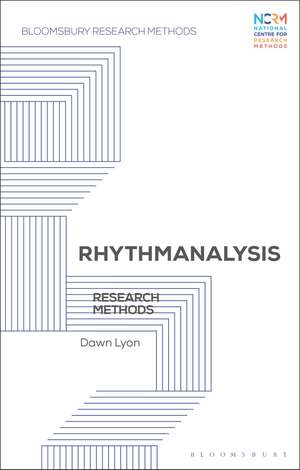Rhythmanalysis: Research Methods: Bloomsbury Research Methods
Autor Dr Dawn Lyonen Limba Engleză Paperback – 23 dec 2020
| Toate formatele și edițiile | Preț | Express |
|---|---|---|
| Paperback (1) | 124.30 lei 3-5 săpt. | +18.71 lei 6-10 zile |
| Bloomsbury Publishing – 23 dec 2020 | 124.30 lei 3-5 săpt. | +18.71 lei 6-10 zile |
| Hardback (1) | 373.36 lei 6-8 săpt. | |
| Bloomsbury Publishing – 23 dec 2020 | 373.36 lei 6-8 săpt. |
Preț: 124.30 lei
Preț vechi: 136.09 lei
-9% Nou
Puncte Express: 186
Preț estimativ în valută:
23.78€ • 24.90$ • 19.73£
23.78€ • 24.90$ • 19.73£
Carte disponibilă
Livrare economică 19 martie-02 aprilie
Livrare express 04-08 martie pentru 28.70 lei
Preluare comenzi: 021 569.72.76
Specificații
ISBN-13: 9781350188907
ISBN-10: 1350188905
Pagini: 144
Dimensiuni: 138 x 216 x 16 mm
Greutate: 0.17 kg
Editura: Bloomsbury Publishing
Colecția Bloomsbury Academic
Seria Bloomsbury Research Methods
Locul publicării:London, United Kingdom
ISBN-10: 1350188905
Pagini: 144
Dimensiuni: 138 x 216 x 16 mm
Greutate: 0.17 kg
Editura: Bloomsbury Publishing
Colecția Bloomsbury Academic
Seria Bloomsbury Research Methods
Locul publicării:London, United Kingdom
Caracteristici
Explores a range of studies in which rhythmanalysis has been applied including research around walking, dancing, commuting and the financial market versus the high frequency trading floor
Notă biografică
Dawn Lyon is Reader in Sociology at the University of Kent, UK.
Cuprins
Series Editor Foreword 1. Introduction to Rhythmanalysis 2. A Brief History of Rhythmanalysis 3. The Application of Rhythmanalysis 4. Gains and Limitations of Rhythmanalysis 5. Future Directions in Rhythmanalysis 6. Summary Annotated Bibliography Index
Recenzii
It is hard to imagine a more engaging, yet succinct introduction to Henri Lefebvre's rhythmanalysis. Surveying the most relevant cross-disciplinary work while continually demonstrating how rhythmanalysis is a practicable method, this book is illuminating and generative in equal measure.
Starting with Lefebvre's thought and tracing its evolution through the current times across the social sciences, Lyon's book presents rhythmanalysis as a family of concepts, a research strategy and a set of field practices intended to sensitize students and scholars to undertake empirical research with attention to the flows of rhythm. The book demystifies the often-misunderstood but ever so popular concept through clear and practical terms and examples, showing us how to better understand social life through the perspective of rhythm and the role of time in the production, imagination, experience, and representation of multiple social realities.
Dawn Lyon's invitation to consider the methodological benefits of adopting rhythmanalysis as a research tool is a no-nonsense, bracing account that generously treats readers to a wealth of empirical examples and theoretical ideas. Rescuing Lefebvre's contentions from the realm of arcane scholarly debate, Lyon provides a wide-ranging, lucid and convivial exploration that grounds rhythmic experience in everyday living while simultaneously extending ways in which rhythm may be conceptualised.
A timely contribution. While rhythmanalysis to date has not been a well-defined methodology, or at least can as much reveal the idiosyncrasies of the researcher, her book offers a clear and thoughtful attempt to characterize what rhythmanalysis might actually look like for a wide range of researchers.
Starting with Lefebvre's thought and tracing its evolution through the current times across the social sciences, Lyon's book presents rhythmanalysis as a family of concepts, a research strategy and a set of field practices intended to sensitize students and scholars to undertake empirical research with attention to the flows of rhythm. The book demystifies the often-misunderstood but ever so popular concept through clear and practical terms and examples, showing us how to better understand social life through the perspective of rhythm and the role of time in the production, imagination, experience, and representation of multiple social realities.
Dawn Lyon's invitation to consider the methodological benefits of adopting rhythmanalysis as a research tool is a no-nonsense, bracing account that generously treats readers to a wealth of empirical examples and theoretical ideas. Rescuing Lefebvre's contentions from the realm of arcane scholarly debate, Lyon provides a wide-ranging, lucid and convivial exploration that grounds rhythmic experience in everyday living while simultaneously extending ways in which rhythm may be conceptualised.
A timely contribution. While rhythmanalysis to date has not been a well-defined methodology, or at least can as much reveal the idiosyncrasies of the researcher, her book offers a clear and thoughtful attempt to characterize what rhythmanalysis might actually look like for a wide range of researchers.












